Literature Review and Gibbs Reflective Cycle
VerifiedAdded on 2020/10/04
|12
|4117
|315
AI Summary
This assignment requires students to analyze a series of articles related to postoperative care, pain management, and critical care in various medical fields. The student is asked to provide a suitable title, meta title, and meta description for an online publication featuring the assignment's content. A summary paragraph must be written detailing the specific requirements of the assignment, including the need for a reflective cycle using Gibbs' framework.
Contribute Materials
Your contribution can guide someone’s learning journey. Share your
documents today.
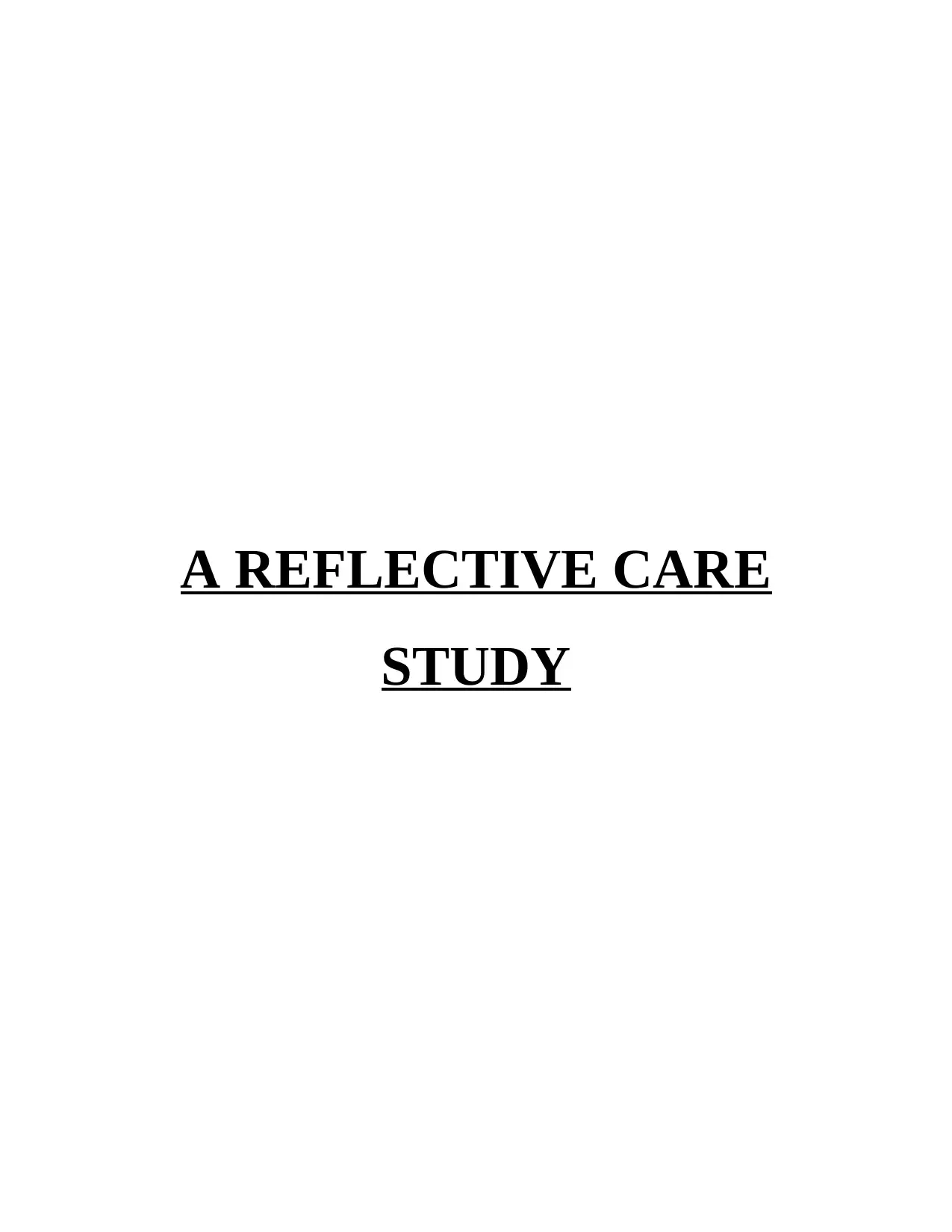
A REFLECTIVE CARE
STUDY
STUDY
Secure Best Marks with AI Grader
Need help grading? Try our AI Grader for instant feedback on your assignments.
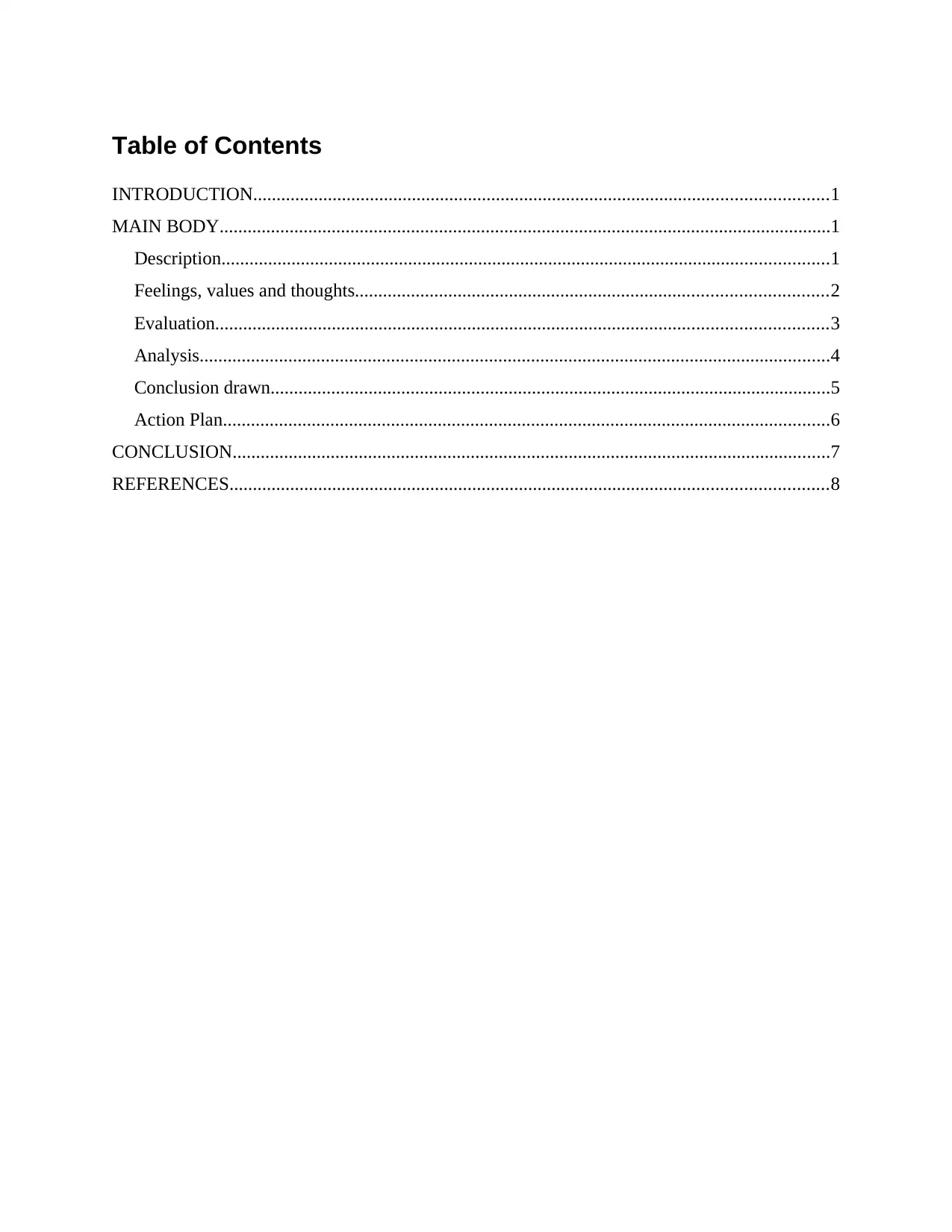
Table of Contents
INTRODUCTION...........................................................................................................................1
MAIN BODY...................................................................................................................................1
Description..................................................................................................................................1
Feelings, values and thoughts.....................................................................................................2
Evaluation...................................................................................................................................3
Analysis.......................................................................................................................................4
Conclusion drawn........................................................................................................................5
Action Plan..................................................................................................................................6
CONCLUSION................................................................................................................................7
REFERENCES................................................................................................................................8
INTRODUCTION...........................................................................................................................1
MAIN BODY...................................................................................................................................1
Description..................................................................................................................................1
Feelings, values and thoughts.....................................................................................................2
Evaluation...................................................................................................................................3
Analysis.......................................................................................................................................4
Conclusion drawn........................................................................................................................5
Action Plan..................................................................................................................................6
CONCLUSION................................................................................................................................7
REFERENCES................................................................................................................................8
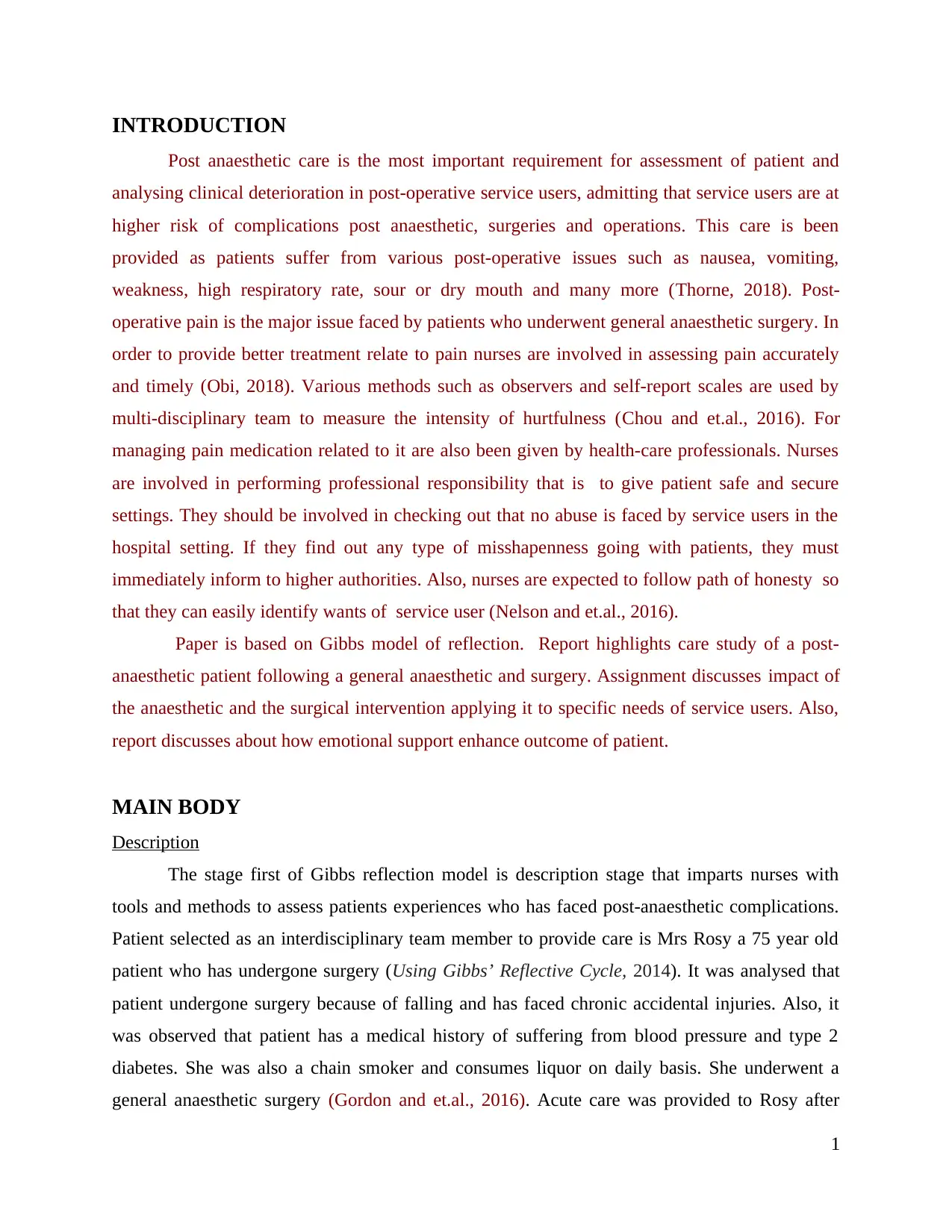
INTRODUCTION
Post anaesthetic care is the most important requirement for assessment of patient and
analysing clinical deterioration in post-operative service users, admitting that service users are at
higher risk of complications post anaesthetic, surgeries and operations. This care is been
provided as patients suffer from various post-operative issues such as nausea, vomiting,
weakness, high respiratory rate, sour or dry mouth and many more (Thorne, 2018). Post-
operative pain is the major issue faced by patients who underwent general anaesthetic surgery. In
order to provide better treatment relate to pain nurses are involved in assessing pain accurately
and timely (Obi, 2018). Various methods such as observers and self-report scales are used by
multi-disciplinary team to measure the intensity of hurtfulness (Chou and et.al., 2016). For
managing pain medication related to it are also been given by health-care professionals. Nurses
are involved in performing professional responsibility that is to give patient safe and secure
settings. They should be involved in checking out that no abuse is faced by service users in the
hospital setting. If they find out any type of misshapenness going with patients, they must
immediately inform to higher authorities. Also, nurses are expected to follow path of honesty so
that they can easily identify wants of service user (Nelson and et.al., 2016).
Paper is based on Gibbs model of reflection. Report highlights care study of a post-
anaesthetic patient following a general anaesthetic and surgery. Assignment discusses impact of
the anaesthetic and the surgical intervention applying it to specific needs of service users. Also,
report discusses about how emotional support enhance outcome of patient.
MAIN BODY
Description
The stage first of Gibbs reflection model is description stage that imparts nurses with
tools and methods to assess patients experiences who has faced post-anaesthetic complications.
Patient selected as an interdisciplinary team member to provide care is Mrs Rosy a 75 year old
patient who has undergone surgery (Using Gibbs’ Reflective Cycle, 2014). It was analysed that
patient undergone surgery because of falling and has faced chronic accidental injuries. Also, it
was observed that patient has a medical history of suffering from blood pressure and type 2
diabetes. She was also a chain smoker and consumes liquor on daily basis. She underwent a
general anaesthetic surgery (Gordon and et.al., 2016). Acute care was provided to Rosy after
1
Post anaesthetic care is the most important requirement for assessment of patient and
analysing clinical deterioration in post-operative service users, admitting that service users are at
higher risk of complications post anaesthetic, surgeries and operations. This care is been
provided as patients suffer from various post-operative issues such as nausea, vomiting,
weakness, high respiratory rate, sour or dry mouth and many more (Thorne, 2018). Post-
operative pain is the major issue faced by patients who underwent general anaesthetic surgery. In
order to provide better treatment relate to pain nurses are involved in assessing pain accurately
and timely (Obi, 2018). Various methods such as observers and self-report scales are used by
multi-disciplinary team to measure the intensity of hurtfulness (Chou and et.al., 2016). For
managing pain medication related to it are also been given by health-care professionals. Nurses
are involved in performing professional responsibility that is to give patient safe and secure
settings. They should be involved in checking out that no abuse is faced by service users in the
hospital setting. If they find out any type of misshapenness going with patients, they must
immediately inform to higher authorities. Also, nurses are expected to follow path of honesty so
that they can easily identify wants of service user (Nelson and et.al., 2016).
Paper is based on Gibbs model of reflection. Report highlights care study of a post-
anaesthetic patient following a general anaesthetic and surgery. Assignment discusses impact of
the anaesthetic and the surgical intervention applying it to specific needs of service users. Also,
report discusses about how emotional support enhance outcome of patient.
MAIN BODY
Description
The stage first of Gibbs reflection model is description stage that imparts nurses with
tools and methods to assess patients experiences who has faced post-anaesthetic complications.
Patient selected as an interdisciplinary team member to provide care is Mrs Rosy a 75 year old
patient who has undergone surgery (Using Gibbs’ Reflective Cycle, 2014). It was analysed that
patient undergone surgery because of falling and has faced chronic accidental injuries. Also, it
was observed that patient has a medical history of suffering from blood pressure and type 2
diabetes. She was also a chain smoker and consumes liquor on daily basis. She underwent a
general anaesthetic surgery (Gordon and et.al., 2016). Acute care was provided to Rosy after
1

surgery as general anaesthesia works by hampering the signals of nerve in human brain. She has
two daughters who lived far away from her and meets her one's in a month. Also, Rosy was
suffering from depression after getting separated from her husband. She was usually quiet and
facing feelings of loneliness, sadness and depression.
Anaesthesia was given to patient by using a IV that goes directly into her veins of hand.
After imparting service user with general anaesthesia, she was shifted to PACU where acute care
and treatment was given to her. In this care unit nurses ensured that patients after surgery all the
anaesthetic medicines given to service users are being stopped and pain is been managed. Also,
health-care professionals team is being involved in analysing and observing the signs and
symbols of acute changes in service user (Gordon and et.al., 2016). Nurses lays more emphasis
on elderly aged patients acknowledging that they face more clinical complexities after post-
anaesthetic surgery. Health-care professionals are engaged in giving acute treatment as Rosy is
diabetic patient and they are at more risk of having issues like memory loss, heart and lung
disease (Devin and McGirt, 2015). For these nurses are indulged in imparting timely and acute
care to patient so that they can overcome complications.
Feelings, values and thoughts
Nursing is an emotional job and as a member of inter-professional team I was expected to
provide the best care to patient who has suffered accidental injury and has undergone general
anaesthetic surgery. While giving post-anaesthetic care to Mrs. Rosy in PACU I was quiet
emotional as patient was going through a lot of sufferance after surgery. Also, I was feeling sad
and depressed after seeing the condition of Mrs. Rosy. As I have spent more time towards her, it
upsets me more. I was engaged in giving care according to her needs and demands. As an inter-
professional team member my only aim was to provide the best treatment to Rosy so that she do
not face any post-anaesthetic complexities. While treating service users I was thinking about
what steps I would follow in order to achieve my aims and objectives. My target was to impart
patient with timely care so that she can be discharged early from hospital. I had a positive feeling
towards Rosy that helped me in imparting the treatment that will support patient in improving
there health outcome. I was able to understood the critical situation and condition faced by
service user that made me sad, anxious and distressed.
Also, I was engaged in providing services based on ethical principles that includes
honesty, beneficence and autonomy. It means that inter-professional team was involved in giving
2
two daughters who lived far away from her and meets her one's in a month. Also, Rosy was
suffering from depression after getting separated from her husband. She was usually quiet and
facing feelings of loneliness, sadness and depression.
Anaesthesia was given to patient by using a IV that goes directly into her veins of hand.
After imparting service user with general anaesthesia, she was shifted to PACU where acute care
and treatment was given to her. In this care unit nurses ensured that patients after surgery all the
anaesthetic medicines given to service users are being stopped and pain is been managed. Also,
health-care professionals team is being involved in analysing and observing the signs and
symbols of acute changes in service user (Gordon and et.al., 2016). Nurses lays more emphasis
on elderly aged patients acknowledging that they face more clinical complexities after post-
anaesthetic surgery. Health-care professionals are engaged in giving acute treatment as Rosy is
diabetic patient and they are at more risk of having issues like memory loss, heart and lung
disease (Devin and McGirt, 2015). For these nurses are indulged in imparting timely and acute
care to patient so that they can overcome complications.
Feelings, values and thoughts
Nursing is an emotional job and as a member of inter-professional team I was expected to
provide the best care to patient who has suffered accidental injury and has undergone general
anaesthetic surgery. While giving post-anaesthetic care to Mrs. Rosy in PACU I was quiet
emotional as patient was going through a lot of sufferance after surgery. Also, I was feeling sad
and depressed after seeing the condition of Mrs. Rosy. As I have spent more time towards her, it
upsets me more. I was engaged in giving care according to her needs and demands. As an inter-
professional team member my only aim was to provide the best treatment to Rosy so that she do
not face any post-anaesthetic complexities. While treating service users I was thinking about
what steps I would follow in order to achieve my aims and objectives. My target was to impart
patient with timely care so that she can be discharged early from hospital. I had a positive feeling
towards Rosy that helped me in imparting the treatment that will support patient in improving
there health outcome. I was able to understood the critical situation and condition faced by
service user that made me sad, anxious and distressed.
Also, I was engaged in providing services based on ethical principles that includes
honesty, beneficence and autonomy. It means that inter-professional team was involved in giving
2
Secure Best Marks with AI Grader
Need help grading? Try our AI Grader for instant feedback on your assignments.
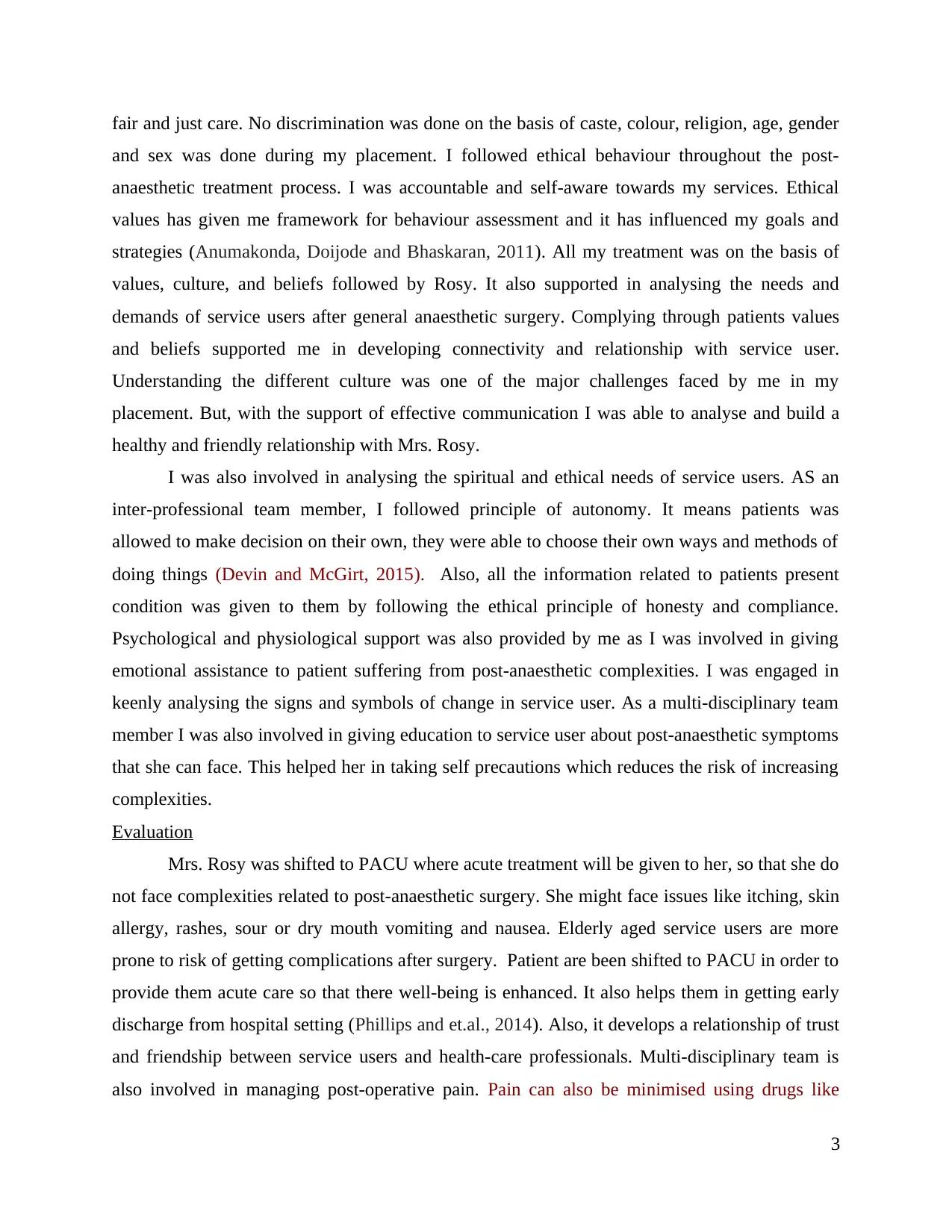
fair and just care. No discrimination was done on the basis of caste, colour, religion, age, gender
and sex was done during my placement. I followed ethical behaviour throughout the post-
anaesthetic treatment process. I was accountable and self-aware towards my services. Ethical
values has given me framework for behaviour assessment and it has influenced my goals and
strategies (Anumakonda, Doijode and Bhaskaran, 2011). All my treatment was on the basis of
values, culture, and beliefs followed by Rosy. It also supported in analysing the needs and
demands of service users after general anaesthetic surgery. Complying through patients values
and beliefs supported me in developing connectivity and relationship with service user.
Understanding the different culture was one of the major challenges faced by me in my
placement. But, with the support of effective communication I was able to analyse and build a
healthy and friendly relationship with Mrs. Rosy.
I was also involved in analysing the spiritual and ethical needs of service users. AS an
inter-professional team member, I followed principle of autonomy. It means patients was
allowed to make decision on their own, they were able to choose their own ways and methods of
doing things (Devin and McGirt, 2015). Also, all the information related to patients present
condition was given to them by following the ethical principle of honesty and compliance.
Psychological and physiological support was also provided by me as I was involved in giving
emotional assistance to patient suffering from post-anaesthetic complexities. I was engaged in
keenly analysing the signs and symbols of change in service user. As a multi-disciplinary team
member I was also involved in giving education to service user about post-anaesthetic symptoms
that she can face. This helped her in taking self precautions which reduces the risk of increasing
complexities.
Evaluation
Mrs. Rosy was shifted to PACU where acute treatment will be given to her, so that she do
not face complexities related to post-anaesthetic surgery. She might face issues like itching, skin
allergy, rashes, sour or dry mouth vomiting and nausea. Elderly aged service users are more
prone to risk of getting complications after surgery. Patient are been shifted to PACU in order to
provide them acute care so that there well-being is enhanced. It also helps them in getting early
discharge from hospital setting (Phillips and et.al., 2014). Also, it develops a relationship of trust
and friendship between service users and health-care professionals. Multi-disciplinary team is
also involved in managing post-operative pain. Pain can also be minimised using drugs like
3
and sex was done during my placement. I followed ethical behaviour throughout the post-
anaesthetic treatment process. I was accountable and self-aware towards my services. Ethical
values has given me framework for behaviour assessment and it has influenced my goals and
strategies (Anumakonda, Doijode and Bhaskaran, 2011). All my treatment was on the basis of
values, culture, and beliefs followed by Rosy. It also supported in analysing the needs and
demands of service users after general anaesthetic surgery. Complying through patients values
and beliefs supported me in developing connectivity and relationship with service user.
Understanding the different culture was one of the major challenges faced by me in my
placement. But, with the support of effective communication I was able to analyse and build a
healthy and friendly relationship with Mrs. Rosy.
I was also involved in analysing the spiritual and ethical needs of service users. AS an
inter-professional team member, I followed principle of autonomy. It means patients was
allowed to make decision on their own, they were able to choose their own ways and methods of
doing things (Devin and McGirt, 2015). Also, all the information related to patients present
condition was given to them by following the ethical principle of honesty and compliance.
Psychological and physiological support was also provided by me as I was involved in giving
emotional assistance to patient suffering from post-anaesthetic complexities. I was engaged in
keenly analysing the signs and symbols of change in service user. As a multi-disciplinary team
member I was also involved in giving education to service user about post-anaesthetic symptoms
that she can face. This helped her in taking self precautions which reduces the risk of increasing
complexities.
Evaluation
Mrs. Rosy was shifted to PACU where acute treatment will be given to her, so that she do
not face complexities related to post-anaesthetic surgery. She might face issues like itching, skin
allergy, rashes, sour or dry mouth vomiting and nausea. Elderly aged service users are more
prone to risk of getting complications after surgery. Patient are been shifted to PACU in order to
provide them acute care so that there well-being is enhanced. It also helps them in getting early
discharge from hospital setting (Phillips and et.al., 2014). Also, it develops a relationship of trust
and friendship between service users and health-care professionals. Multi-disciplinary team is
also involved in managing post-operative pain. Pain can also be minimised using drugs like
3
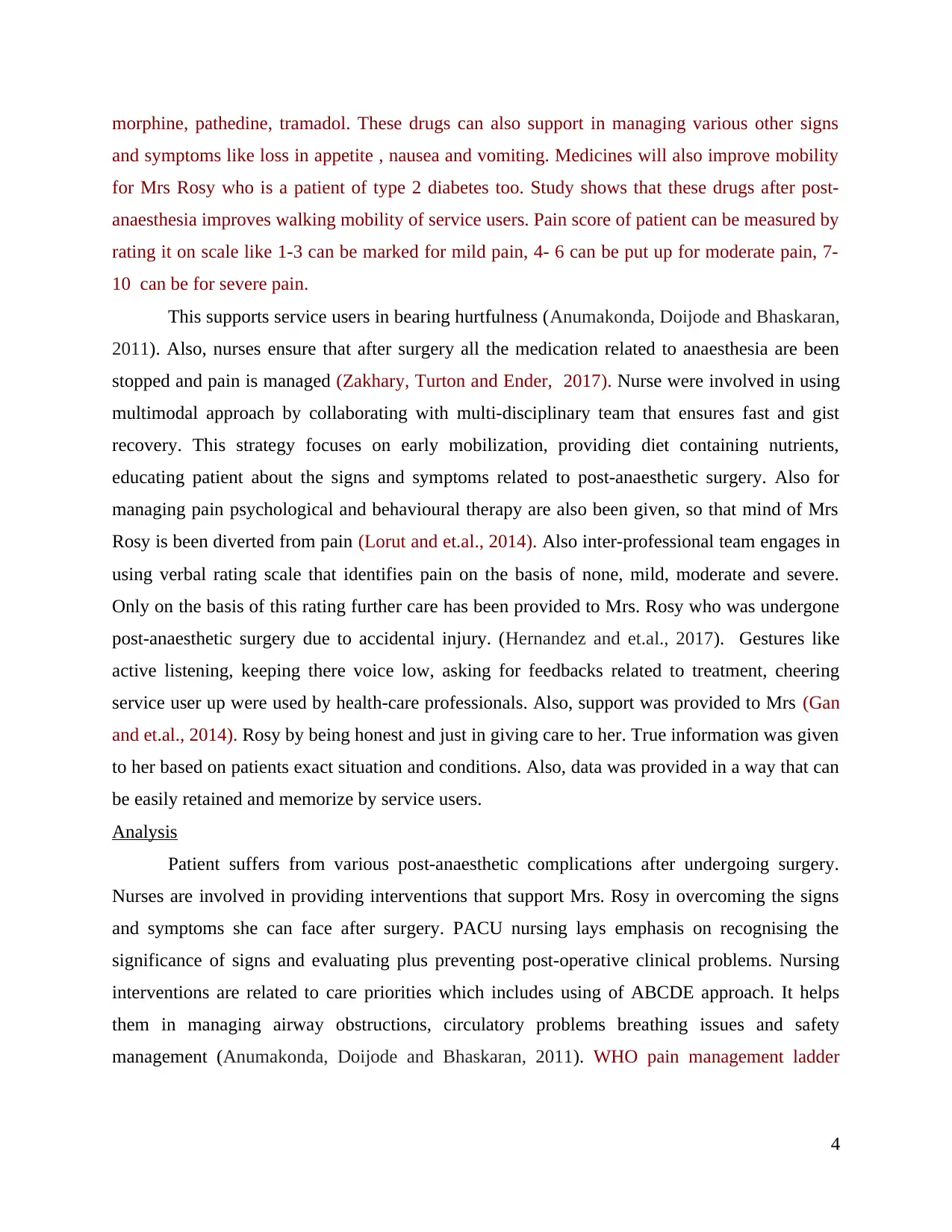
morphine, pathedine, tramadol. These drugs can also support in managing various other signs
and symptoms like loss in appetite , nausea and vomiting. Medicines will also improve mobility
for Mrs Rosy who is a patient of type 2 diabetes too. Study shows that these drugs after post-
anaesthesia improves walking mobility of service users. Pain score of patient can be measured by
rating it on scale like 1-3 can be marked for mild pain, 4- 6 can be put up for moderate pain, 7-
10 can be for severe pain.
This supports service users in bearing hurtfulness (Anumakonda, Doijode and Bhaskaran,
2011). Also, nurses ensure that after surgery all the medication related to anaesthesia are been
stopped and pain is managed (Zakhary, Turton and Ender, 2017). Nurse were involved in using
multimodal approach by collaborating with multi-disciplinary team that ensures fast and gist
recovery. This strategy focuses on early mobilization, providing diet containing nutrients,
educating patient about the signs and symptoms related to post-anaesthetic surgery. Also for
managing pain psychological and behavioural therapy are also been given, so that mind of Mrs
Rosy is been diverted from pain (Lorut and et.al., 2014). Also inter-professional team engages in
using verbal rating scale that identifies pain on the basis of none, mild, moderate and severe.
Only on the basis of this rating further care has been provided to Mrs. Rosy who was undergone
post-anaesthetic surgery due to accidental injury. (Hernandez and et.al., 2017). Gestures like
active listening, keeping there voice low, asking for feedbacks related to treatment, cheering
service user up were used by health-care professionals. Also, support was provided to Mrs (Gan
and et.al., 2014). Rosy by being honest and just in giving care to her. True information was given
to her based on patients exact situation and conditions. Also, data was provided in a way that can
be easily retained and memorize by service users.
Analysis
Patient suffers from various post-anaesthetic complications after undergoing surgery.
Nurses are involved in providing interventions that support Mrs. Rosy in overcoming the signs
and symptoms she can face after surgery. PACU nursing lays emphasis on recognising the
significance of signs and evaluating plus preventing post-operative clinical problems. Nursing
interventions are related to care priorities which includes using of ABCDE approach. It helps
them in managing airway obstructions, circulatory problems breathing issues and safety
management (Anumakonda, Doijode and Bhaskaran, 2011). WHO pain management ladder
4
and symptoms like loss in appetite , nausea and vomiting. Medicines will also improve mobility
for Mrs Rosy who is a patient of type 2 diabetes too. Study shows that these drugs after post-
anaesthesia improves walking mobility of service users. Pain score of patient can be measured by
rating it on scale like 1-3 can be marked for mild pain, 4- 6 can be put up for moderate pain, 7-
10 can be for severe pain.
This supports service users in bearing hurtfulness (Anumakonda, Doijode and Bhaskaran,
2011). Also, nurses ensure that after surgery all the medication related to anaesthesia are been
stopped and pain is managed (Zakhary, Turton and Ender, 2017). Nurse were involved in using
multimodal approach by collaborating with multi-disciplinary team that ensures fast and gist
recovery. This strategy focuses on early mobilization, providing diet containing nutrients,
educating patient about the signs and symptoms related to post-anaesthetic surgery. Also for
managing pain psychological and behavioural therapy are also been given, so that mind of Mrs
Rosy is been diverted from pain (Lorut and et.al., 2014). Also inter-professional team engages in
using verbal rating scale that identifies pain on the basis of none, mild, moderate and severe.
Only on the basis of this rating further care has been provided to Mrs. Rosy who was undergone
post-anaesthetic surgery due to accidental injury. (Hernandez and et.al., 2017). Gestures like
active listening, keeping there voice low, asking for feedbacks related to treatment, cheering
service user up were used by health-care professionals. Also, support was provided to Mrs (Gan
and et.al., 2014). Rosy by being honest and just in giving care to her. True information was given
to her based on patients exact situation and conditions. Also, data was provided in a way that can
be easily retained and memorize by service users.
Analysis
Patient suffers from various post-anaesthetic complications after undergoing surgery.
Nurses are involved in providing interventions that support Mrs. Rosy in overcoming the signs
and symptoms she can face after surgery. PACU nursing lays emphasis on recognising the
significance of signs and evaluating plus preventing post-operative clinical problems. Nursing
interventions are related to care priorities which includes using of ABCDE approach. It helps
them in managing airway obstructions, circulatory problems breathing issues and safety
management (Anumakonda, Doijode and Bhaskaran, 2011). WHO pain management ladder
4
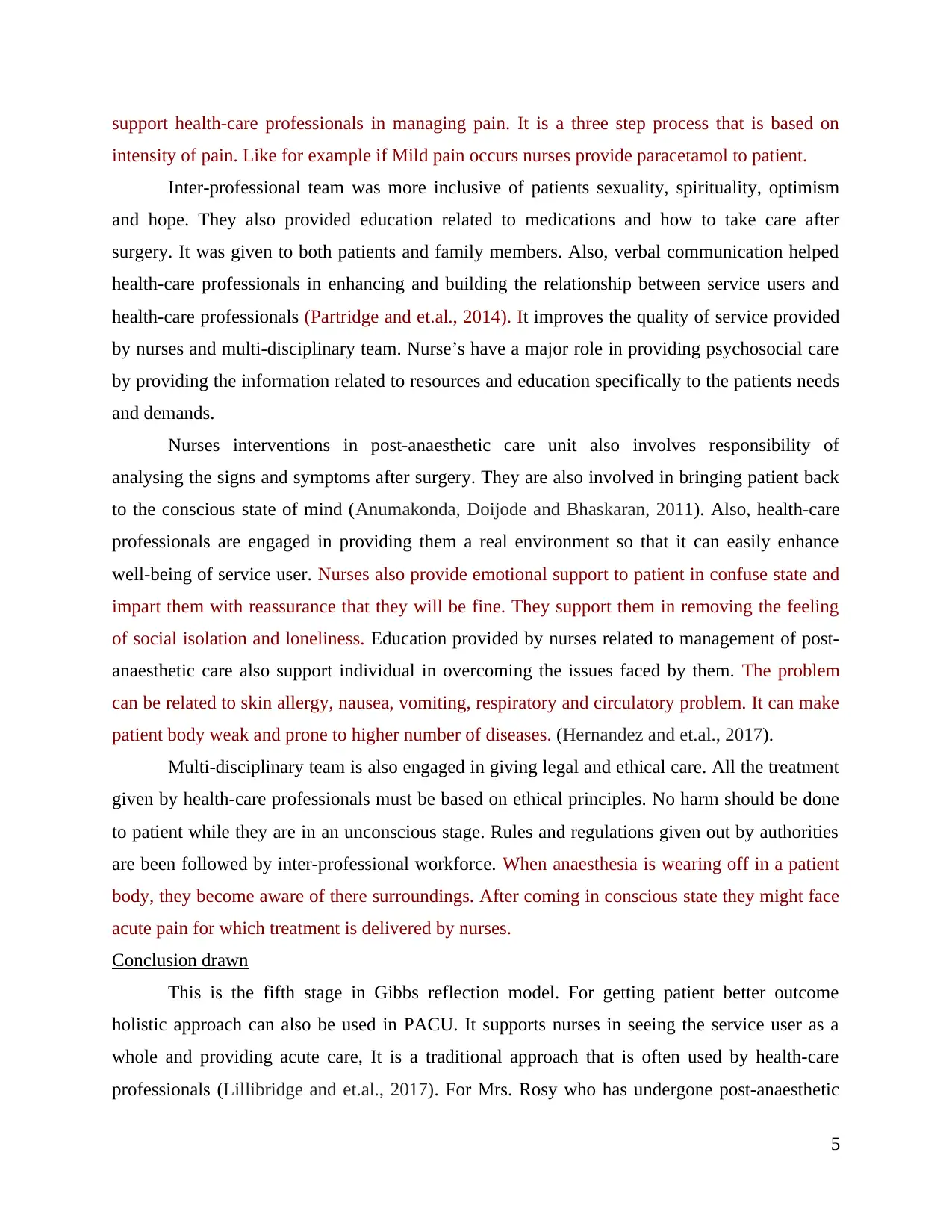
support health-care professionals in managing pain. It is a three step process that is based on
intensity of pain. Like for example if Mild pain occurs nurses provide paracetamol to patient.
Inter-professional team was more inclusive of patients sexuality, spirituality, optimism
and hope. They also provided education related to medications and how to take care after
surgery. It was given to both patients and family members. Also, verbal communication helped
health-care professionals in enhancing and building the relationship between service users and
health-care professionals (Partridge and et.al., 2014). It improves the quality of service provided
by nurses and multi-disciplinary team. Nurse’s have a major role in providing psychosocial care
by providing the information related to resources and education specifically to the patients needs
and demands.
Nurses interventions in post-anaesthetic care unit also involves responsibility of
analysing the signs and symptoms after surgery. They are also involved in bringing patient back
to the conscious state of mind (Anumakonda, Doijode and Bhaskaran, 2011). Also, health-care
professionals are engaged in providing them a real environment so that it can easily enhance
well-being of service user. Nurses also provide emotional support to patient in confuse state and
impart them with reassurance that they will be fine. They support them in removing the feeling
of social isolation and loneliness. Education provided by nurses related to management of post-
anaesthetic care also support individual in overcoming the issues faced by them. The problem
can be related to skin allergy, nausea, vomiting, respiratory and circulatory problem. It can make
patient body weak and prone to higher number of diseases. (Hernandez and et.al., 2017).
Multi-disciplinary team is also engaged in giving legal and ethical care. All the treatment
given by health-care professionals must be based on ethical principles. No harm should be done
to patient while they are in an unconscious stage. Rules and regulations given out by authorities
are been followed by inter-professional workforce. When anaesthesia is wearing off in a patient
body, they become aware of there surroundings. After coming in conscious state they might face
acute pain for which treatment is delivered by nurses.
Conclusion drawn
This is the fifth stage in Gibbs reflection model. For getting patient better outcome
holistic approach can also be used in PACU. It supports nurses in seeing the service user as a
whole and providing acute care, It is a traditional approach that is often used by health-care
professionals (Lillibridge and et.al., 2017). For Mrs. Rosy who has undergone post-anaesthetic
5
intensity of pain. Like for example if Mild pain occurs nurses provide paracetamol to patient.
Inter-professional team was more inclusive of patients sexuality, spirituality, optimism
and hope. They also provided education related to medications and how to take care after
surgery. It was given to both patients and family members. Also, verbal communication helped
health-care professionals in enhancing and building the relationship between service users and
health-care professionals (Partridge and et.al., 2014). It improves the quality of service provided
by nurses and multi-disciplinary team. Nurse’s have a major role in providing psychosocial care
by providing the information related to resources and education specifically to the patients needs
and demands.
Nurses interventions in post-anaesthetic care unit also involves responsibility of
analysing the signs and symptoms after surgery. They are also involved in bringing patient back
to the conscious state of mind (Anumakonda, Doijode and Bhaskaran, 2011). Also, health-care
professionals are engaged in providing them a real environment so that it can easily enhance
well-being of service user. Nurses also provide emotional support to patient in confuse state and
impart them with reassurance that they will be fine. They support them in removing the feeling
of social isolation and loneliness. Education provided by nurses related to management of post-
anaesthetic care also support individual in overcoming the issues faced by them. The problem
can be related to skin allergy, nausea, vomiting, respiratory and circulatory problem. It can make
patient body weak and prone to higher number of diseases. (Hernandez and et.al., 2017).
Multi-disciplinary team is also engaged in giving legal and ethical care. All the treatment
given by health-care professionals must be based on ethical principles. No harm should be done
to patient while they are in an unconscious stage. Rules and regulations given out by authorities
are been followed by inter-professional workforce. When anaesthesia is wearing off in a patient
body, they become aware of there surroundings. After coming in conscious state they might face
acute pain for which treatment is delivered by nurses.
Conclusion drawn
This is the fifth stage in Gibbs reflection model. For getting patient better outcome
holistic approach can also be used in PACU. It supports nurses in seeing the service user as a
whole and providing acute care, It is a traditional approach that is often used by health-care
professionals (Lillibridge and et.al., 2017). For Mrs. Rosy who has undergone post-anaesthetic
5
Paraphrase This Document
Need a fresh take? Get an instant paraphrase of this document with our AI Paraphraser

surgery due to accidental injury it would be beneficial to use this approach. This will support
nurses in easily understanding the values, beliefs and culture of patient. It lays emphasis on that
patient is self aware about their conditions. Also, pharmacological interventions can also be used
by health-care professionals in order to manage pain (Redley and et.al., 2016). They can also
give support to them by encouraging service user to participate in other activities like physical
exercise such as yoga, aerobics or art and craft tasks. This will divert there mind and manage
pain. Also, medication can be given by nurses as prescribed specialists, doctors or health-care
professionals. Dieticians can be included so that they can take care of patient and impart them
with healthy and fibre rich diet. This will enhance well-being and health outcome of service user.
Person-centred approach can also be used by health-care professionals so that they are
better able to understand Mrs. Rosy feelings and emotions. This will assist them in identifying
the needs and wants of patients. Also, it will create a positive and healthy relationship between
service user and nurses. This approach focuses on that keen analysis and evaluation is been done
of changes that occur in patient after post-anaesthetic surgery. This helps health-care
professionals managing pain. Also, it will develop a trust in mind of service user, which can help
her in improving health outcome easily. This approach also lays focus that patients are keenly
observed.
Action Plan
Nurses will be involved in developing action plan which will support them in achieving
there objectives as well as goals. Target set would be SMART that is specific, measurable,
attainable, relevant and timely. Success in this process would be measured by health-care
professionals by seeing the health outcome of patient undergoing post-anaesthetic complications
(Lillibridge and et.al., 2017). Also, for achieving goal various strategies such as effective
communication, evidence based practice and education will be used by inter-professional team.
This will also help them in easily achieving the target. Also, while achieving goals nurses have a
responsibility that no sentiments of service users are being hurt by them (Kitney and et.al.,
2016).
For improving health outcome of patient evidence based practice will also be used. This
approach will provide a framework that supports multi-disciplinary team in achieving the goals
and objectives. Also, nurses would be involved in motivating and encouraging patient to engage
have positive thoughts and feelings. It will help them in improving the health outcome of service
6
nurses in easily understanding the values, beliefs and culture of patient. It lays emphasis on that
patient is self aware about their conditions. Also, pharmacological interventions can also be used
by health-care professionals in order to manage pain (Redley and et.al., 2016). They can also
give support to them by encouraging service user to participate in other activities like physical
exercise such as yoga, aerobics or art and craft tasks. This will divert there mind and manage
pain. Also, medication can be given by nurses as prescribed specialists, doctors or health-care
professionals. Dieticians can be included so that they can take care of patient and impart them
with healthy and fibre rich diet. This will enhance well-being and health outcome of service user.
Person-centred approach can also be used by health-care professionals so that they are
better able to understand Mrs. Rosy feelings and emotions. This will assist them in identifying
the needs and wants of patients. Also, it will create a positive and healthy relationship between
service user and nurses. This approach focuses on that keen analysis and evaluation is been done
of changes that occur in patient after post-anaesthetic surgery. This helps health-care
professionals managing pain. Also, it will develop a trust in mind of service user, which can help
her in improving health outcome easily. This approach also lays focus that patients are keenly
observed.
Action Plan
Nurses will be involved in developing action plan which will support them in achieving
there objectives as well as goals. Target set would be SMART that is specific, measurable,
attainable, relevant and timely. Success in this process would be measured by health-care
professionals by seeing the health outcome of patient undergoing post-anaesthetic complications
(Lillibridge and et.al., 2017). Also, for achieving goal various strategies such as effective
communication, evidence based practice and education will be used by inter-professional team.
This will also help them in easily achieving the target. Also, while achieving goals nurses have a
responsibility that no sentiments of service users are being hurt by them (Kitney and et.al.,
2016).
For improving health outcome of patient evidence based practice will also be used. This
approach will provide a framework that supports multi-disciplinary team in achieving the goals
and objectives. Also, nurses would be involved in motivating and encouraging patient to engage
have positive thoughts and feelings. It will help them in improving the health outcome of service
6
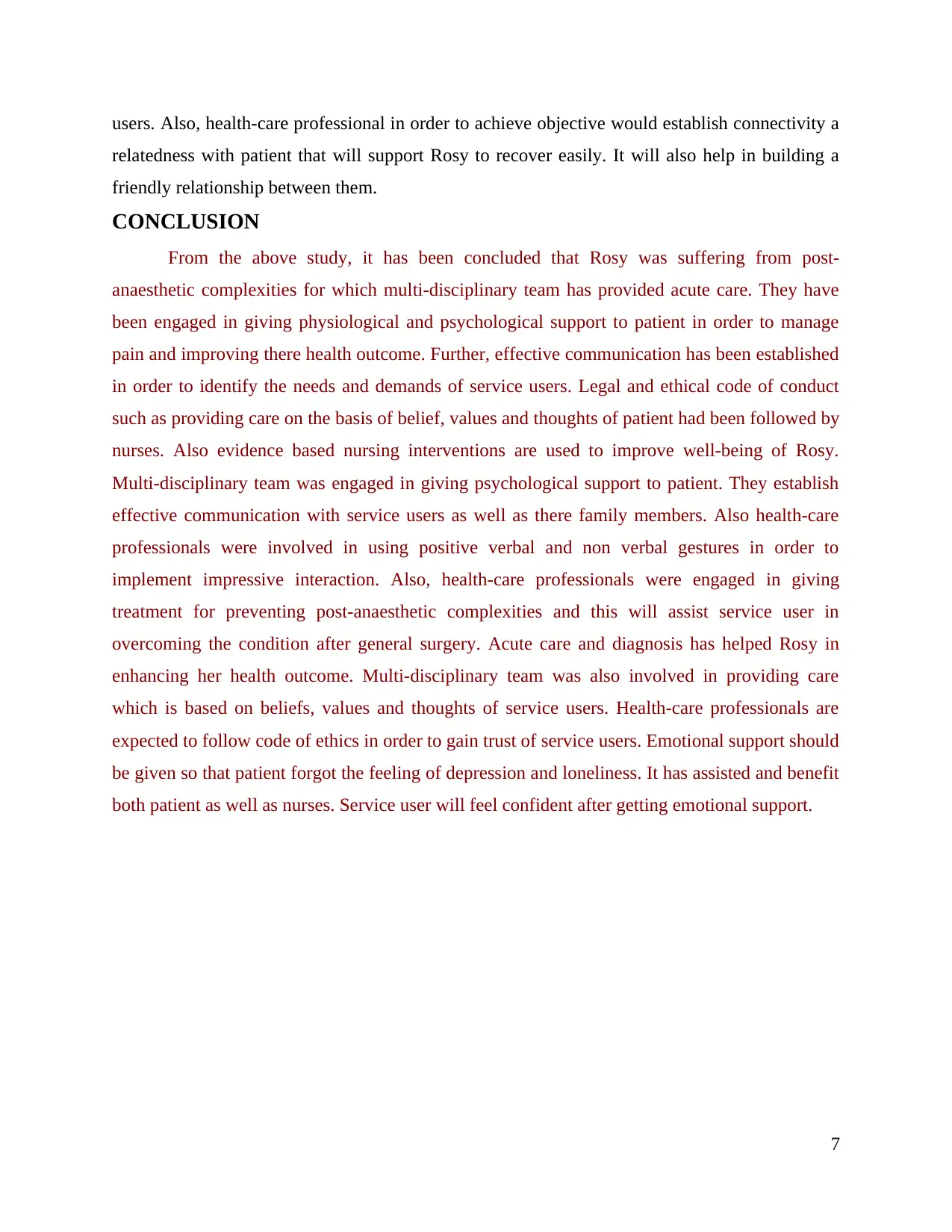
users. Also, health-care professional in order to achieve objective would establish connectivity a
relatedness with patient that will support Rosy to recover easily. It will also help in building a
friendly relationship between them.
CONCLUSION
From the above study, it has been concluded that Rosy was suffering from post-
anaesthetic complexities for which multi-disciplinary team has provided acute care. They have
been engaged in giving physiological and psychological support to patient in order to manage
pain and improving there health outcome. Further, effective communication has been established
in order to identify the needs and demands of service users. Legal and ethical code of conduct
such as providing care on the basis of belief, values and thoughts of patient had been followed by
nurses. Also evidence based nursing interventions are used to improve well-being of Rosy.
Multi-disciplinary team was engaged in giving psychological support to patient. They establish
effective communication with service users as well as there family members. Also health-care
professionals were involved in using positive verbal and non verbal gestures in order to
implement impressive interaction. Also, health-care professionals were engaged in giving
treatment for preventing post-anaesthetic complexities and this will assist service user in
overcoming the condition after general surgery. Acute care and diagnosis has helped Rosy in
enhancing her health outcome. Multi-disciplinary team was also involved in providing care
which is based on beliefs, values and thoughts of service users. Health-care professionals are
expected to follow code of ethics in order to gain trust of service users. Emotional support should
be given so that patient forgot the feeling of depression and loneliness. It has assisted and benefit
both patient as well as nurses. Service user will feel confident after getting emotional support.
7
relatedness with patient that will support Rosy to recover easily. It will also help in building a
friendly relationship between them.
CONCLUSION
From the above study, it has been concluded that Rosy was suffering from post-
anaesthetic complexities for which multi-disciplinary team has provided acute care. They have
been engaged in giving physiological and psychological support to patient in order to manage
pain and improving there health outcome. Further, effective communication has been established
in order to identify the needs and demands of service users. Legal and ethical code of conduct
such as providing care on the basis of belief, values and thoughts of patient had been followed by
nurses. Also evidence based nursing interventions are used to improve well-being of Rosy.
Multi-disciplinary team was engaged in giving psychological support to patient. They establish
effective communication with service users as well as there family members. Also health-care
professionals were involved in using positive verbal and non verbal gestures in order to
implement impressive interaction. Also, health-care professionals were engaged in giving
treatment for preventing post-anaesthetic complexities and this will assist service user in
overcoming the condition after general surgery. Acute care and diagnosis has helped Rosy in
enhancing her health outcome. Multi-disciplinary team was also involved in providing care
which is based on beliefs, values and thoughts of service users. Health-care professionals are
expected to follow code of ethics in order to gain trust of service users. Emotional support should
be given so that patient forgot the feeling of depression and loneliness. It has assisted and benefit
both patient as well as nurses. Service user will feel confident after getting emotional support.
7
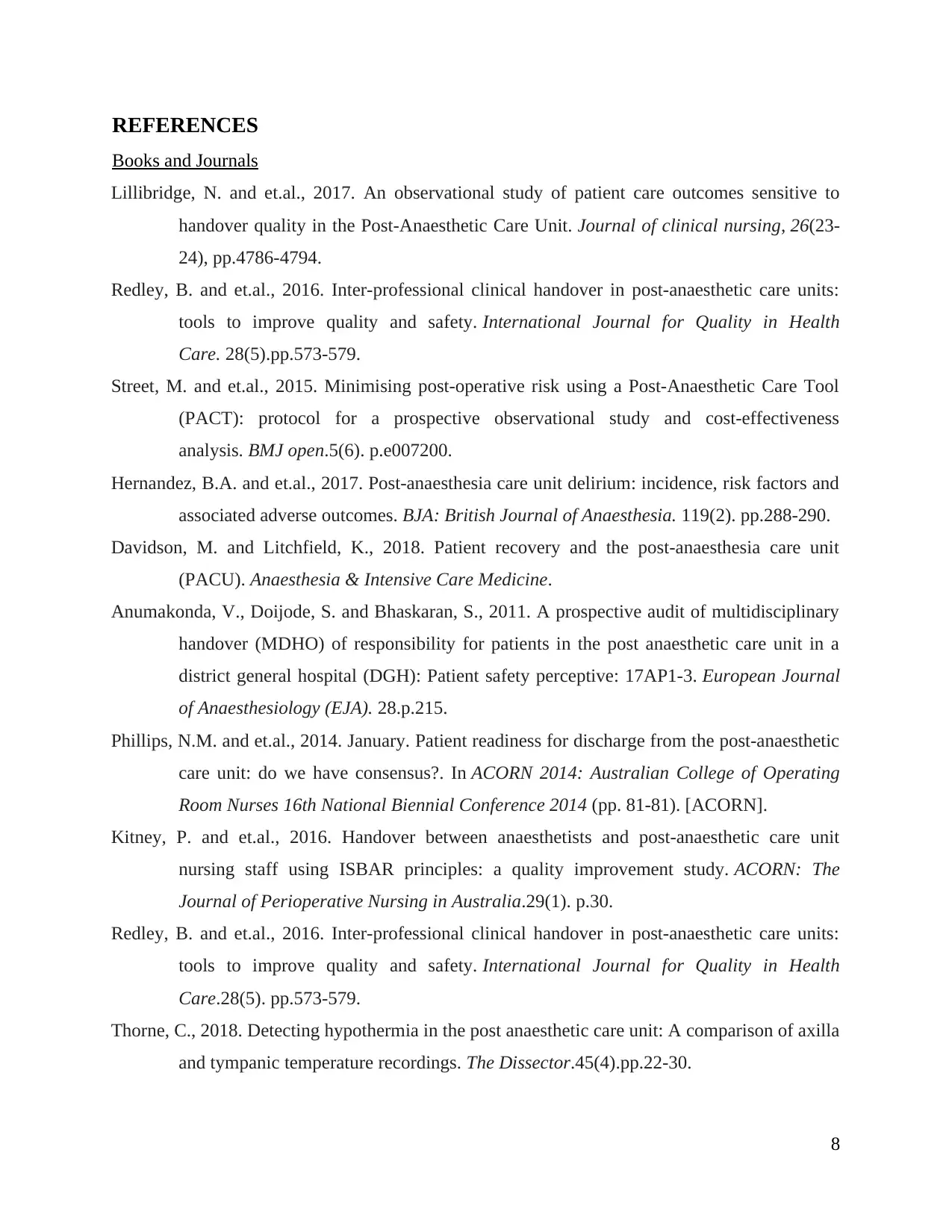
REFERENCES
Books and Journals
Lillibridge, N. and et.al., 2017. An observational study of patient care outcomes sensitive to
handover quality in the Post‐Anaesthetic Care Unit. Journal of clinical nursing, 26(23-
24), pp.4786-4794.
Redley, B. and et.al., 2016. Inter-professional clinical handover in post-anaesthetic care units:
tools to improve quality and safety. International Journal for Quality in Health
Care. 28(5).pp.573-579.
Street, M. and et.al., 2015. Minimising post-operative risk using a Post-Anaesthetic Care Tool
(PACT): protocol for a prospective observational study and cost-effectiveness
analysis. BMJ open.5(6). p.e007200.
Hernandez, B.A. and et.al., 2017. Post-anaesthesia care unit delirium: incidence, risk factors and
associated adverse outcomes. BJA: British Journal of Anaesthesia. 119(2). pp.288-290.
Davidson, M. and Litchfield, K., 2018. Patient recovery and the post-anaesthesia care unit
(PACU). Anaesthesia & Intensive Care Medicine.
Anumakonda, V., Doijode, S. and Bhaskaran, S., 2011. A prospective audit of multidisciplinary
handover (MDHO) of responsibility for patients in the post anaesthetic care unit in a
district general hospital (DGH): Patient safety perceptive: 17AP1-3. European Journal
of Anaesthesiology (EJA). 28.p.215.
Phillips, N.M. and et.al., 2014. January. Patient readiness for discharge from the post-anaesthetic
care unit: do we have consensus?. In ACORN 2014: Australian College of Operating
Room Nurses 16th National Biennial Conference 2014 (pp. 81-81). [ACORN].
Kitney, P. and et.al., 2016. Handover between anaesthetists and post-anaesthetic care unit
nursing staff using ISBAR principles: a quality improvement study. ACORN: The
Journal of Perioperative Nursing in Australia.29(1). p.30.
Redley, B. and et.al., 2016. Inter-professional clinical handover in post-anaesthetic care units:
tools to improve quality and safety. International Journal for Quality in Health
Care.28(5). pp.573-579.
Thorne, C., 2018. Detecting hypothermia in the post anaesthetic care unit: A comparison of axilla
and tympanic temperature recordings. The Dissector.45(4).pp.22-30.
8
Books and Journals
Lillibridge, N. and et.al., 2017. An observational study of patient care outcomes sensitive to
handover quality in the Post‐Anaesthetic Care Unit. Journal of clinical nursing, 26(23-
24), pp.4786-4794.
Redley, B. and et.al., 2016. Inter-professional clinical handover in post-anaesthetic care units:
tools to improve quality and safety. International Journal for Quality in Health
Care. 28(5).pp.573-579.
Street, M. and et.al., 2015. Minimising post-operative risk using a Post-Anaesthetic Care Tool
(PACT): protocol for a prospective observational study and cost-effectiveness
analysis. BMJ open.5(6). p.e007200.
Hernandez, B.A. and et.al., 2017. Post-anaesthesia care unit delirium: incidence, risk factors and
associated adverse outcomes. BJA: British Journal of Anaesthesia. 119(2). pp.288-290.
Davidson, M. and Litchfield, K., 2018. Patient recovery and the post-anaesthesia care unit
(PACU). Anaesthesia & Intensive Care Medicine.
Anumakonda, V., Doijode, S. and Bhaskaran, S., 2011. A prospective audit of multidisciplinary
handover (MDHO) of responsibility for patients in the post anaesthetic care unit in a
district general hospital (DGH): Patient safety perceptive: 17AP1-3. European Journal
of Anaesthesiology (EJA). 28.p.215.
Phillips, N.M. and et.al., 2014. January. Patient readiness for discharge from the post-anaesthetic
care unit: do we have consensus?. In ACORN 2014: Australian College of Operating
Room Nurses 16th National Biennial Conference 2014 (pp. 81-81). [ACORN].
Kitney, P. and et.al., 2016. Handover between anaesthetists and post-anaesthetic care unit
nursing staff using ISBAR principles: a quality improvement study. ACORN: The
Journal of Perioperative Nursing in Australia.29(1). p.30.
Redley, B. and et.al., 2016. Inter-professional clinical handover in post-anaesthetic care units:
tools to improve quality and safety. International Journal for Quality in Health
Care.28(5). pp.573-579.
Thorne, C., 2018. Detecting hypothermia in the post anaesthetic care unit: A comparison of axilla
and tympanic temperature recordings. The Dissector.45(4).pp.22-30.
8
Secure Best Marks with AI Grader
Need help grading? Try our AI Grader for instant feedback on your assignments.
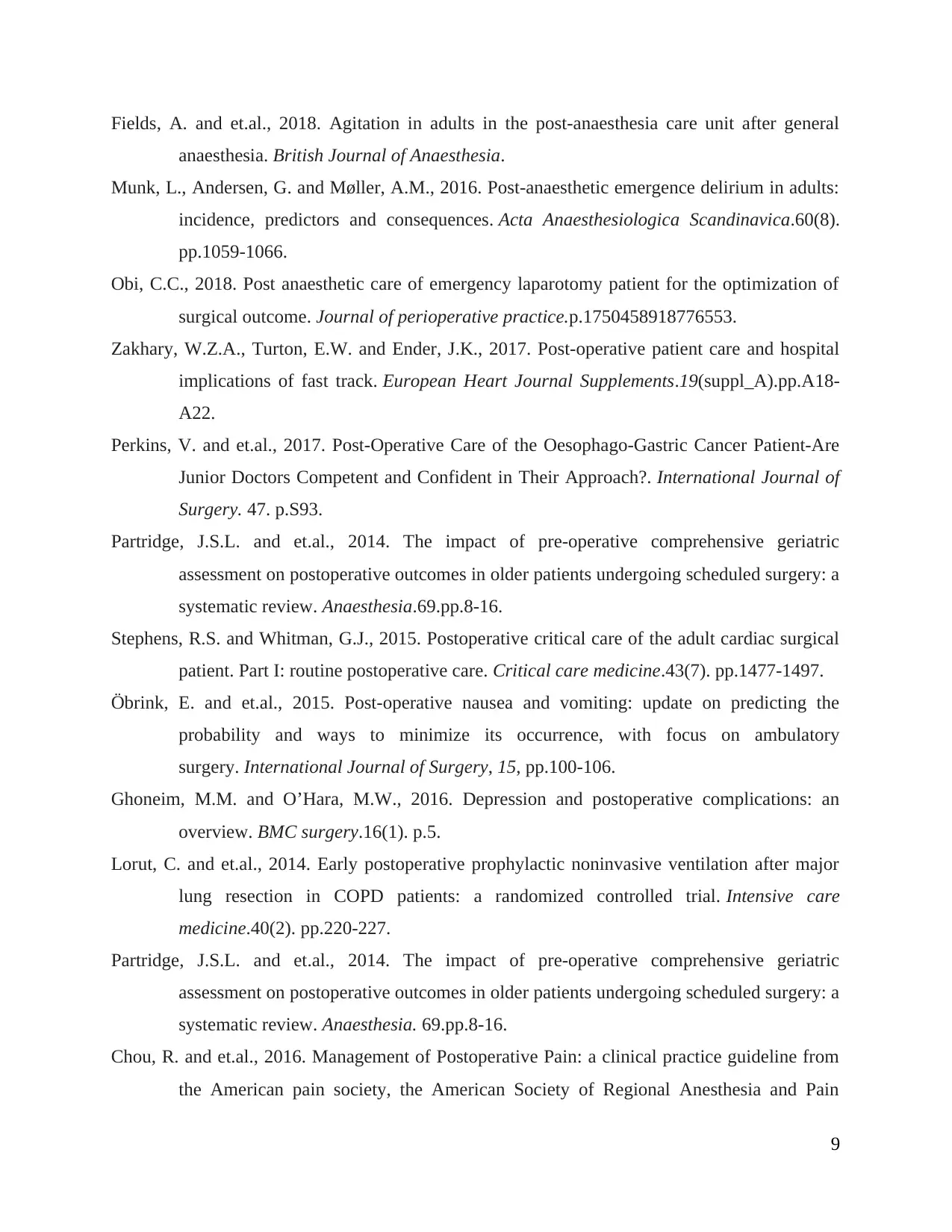
Fields, A. and et.al., 2018. Agitation in adults in the post-anaesthesia care unit after general
anaesthesia. British Journal of Anaesthesia.
Munk, L., Andersen, G. and Møller, A.M., 2016. Post‐anaesthetic emergence delirium in adults:
incidence, predictors and consequences. Acta Anaesthesiologica Scandinavica.60(8).
pp.1059-1066.
Obi, C.C., 2018. Post anaesthetic care of emergency laparotomy patient for the optimization of
surgical outcome. Journal of perioperative practice.p.1750458918776553.
Zakhary, W.Z.A., Turton, E.W. and Ender, J.K., 2017. Post-operative patient care and hospital
implications of fast track. European Heart Journal Supplements.19(suppl_A).pp.A18-
A22.
Perkins, V. and et.al., 2017. Post-Operative Care of the Oesophago-Gastric Cancer Patient-Are
Junior Doctors Competent and Confident in Their Approach?. International Journal of
Surgery. 47. p.S93.
Partridge, J.S.L. and et.al., 2014. The impact of pre‐operative comprehensive geriatric
assessment on postoperative outcomes in older patients undergoing scheduled surgery: a
systematic review. Anaesthesia.69.pp.8-16.
Stephens, R.S. and Whitman, G.J., 2015. Postoperative critical care of the adult cardiac surgical
patient. Part I: routine postoperative care. Critical care medicine.43(7). pp.1477-1497.
Öbrink, E. and et.al., 2015. Post-operative nausea and vomiting: update on predicting the
probability and ways to minimize its occurrence, with focus on ambulatory
surgery. International Journal of Surgery, 15, pp.100-106.
Ghoneim, M.M. and O’Hara, M.W., 2016. Depression and postoperative complications: an
overview. BMC surgery.16(1). p.5.
Lorut, C. and et.al., 2014. Early postoperative prophylactic noninvasive ventilation after major
lung resection in COPD patients: a randomized controlled trial. Intensive care
medicine.40(2). pp.220-227.
Partridge, J.S.L. and et.al., 2014. The impact of pre‐operative comprehensive geriatric
assessment on postoperative outcomes in older patients undergoing scheduled surgery: a
systematic review. Anaesthesia. 69.pp.8-16.
Chou, R. and et.al., 2016. Management of Postoperative Pain: a clinical practice guideline from
the American pain society, the American Society of Regional Anesthesia and Pain
9
anaesthesia. British Journal of Anaesthesia.
Munk, L., Andersen, G. and Møller, A.M., 2016. Post‐anaesthetic emergence delirium in adults:
incidence, predictors and consequences. Acta Anaesthesiologica Scandinavica.60(8).
pp.1059-1066.
Obi, C.C., 2018. Post anaesthetic care of emergency laparotomy patient for the optimization of
surgical outcome. Journal of perioperative practice.p.1750458918776553.
Zakhary, W.Z.A., Turton, E.W. and Ender, J.K., 2017. Post-operative patient care and hospital
implications of fast track. European Heart Journal Supplements.19(suppl_A).pp.A18-
A22.
Perkins, V. and et.al., 2017. Post-Operative Care of the Oesophago-Gastric Cancer Patient-Are
Junior Doctors Competent and Confident in Their Approach?. International Journal of
Surgery. 47. p.S93.
Partridge, J.S.L. and et.al., 2014. The impact of pre‐operative comprehensive geriatric
assessment on postoperative outcomes in older patients undergoing scheduled surgery: a
systematic review. Anaesthesia.69.pp.8-16.
Stephens, R.S. and Whitman, G.J., 2015. Postoperative critical care of the adult cardiac surgical
patient. Part I: routine postoperative care. Critical care medicine.43(7). pp.1477-1497.
Öbrink, E. and et.al., 2015. Post-operative nausea and vomiting: update on predicting the
probability and ways to minimize its occurrence, with focus on ambulatory
surgery. International Journal of Surgery, 15, pp.100-106.
Ghoneim, M.M. and O’Hara, M.W., 2016. Depression and postoperative complications: an
overview. BMC surgery.16(1). p.5.
Lorut, C. and et.al., 2014. Early postoperative prophylactic noninvasive ventilation after major
lung resection in COPD patients: a randomized controlled trial. Intensive care
medicine.40(2). pp.220-227.
Partridge, J.S.L. and et.al., 2014. The impact of pre‐operative comprehensive geriatric
assessment on postoperative outcomes in older patients undergoing scheduled surgery: a
systematic review. Anaesthesia. 69.pp.8-16.
Chou, R. and et.al., 2016. Management of Postoperative Pain: a clinical practice guideline from
the American pain society, the American Society of Regional Anesthesia and Pain
9
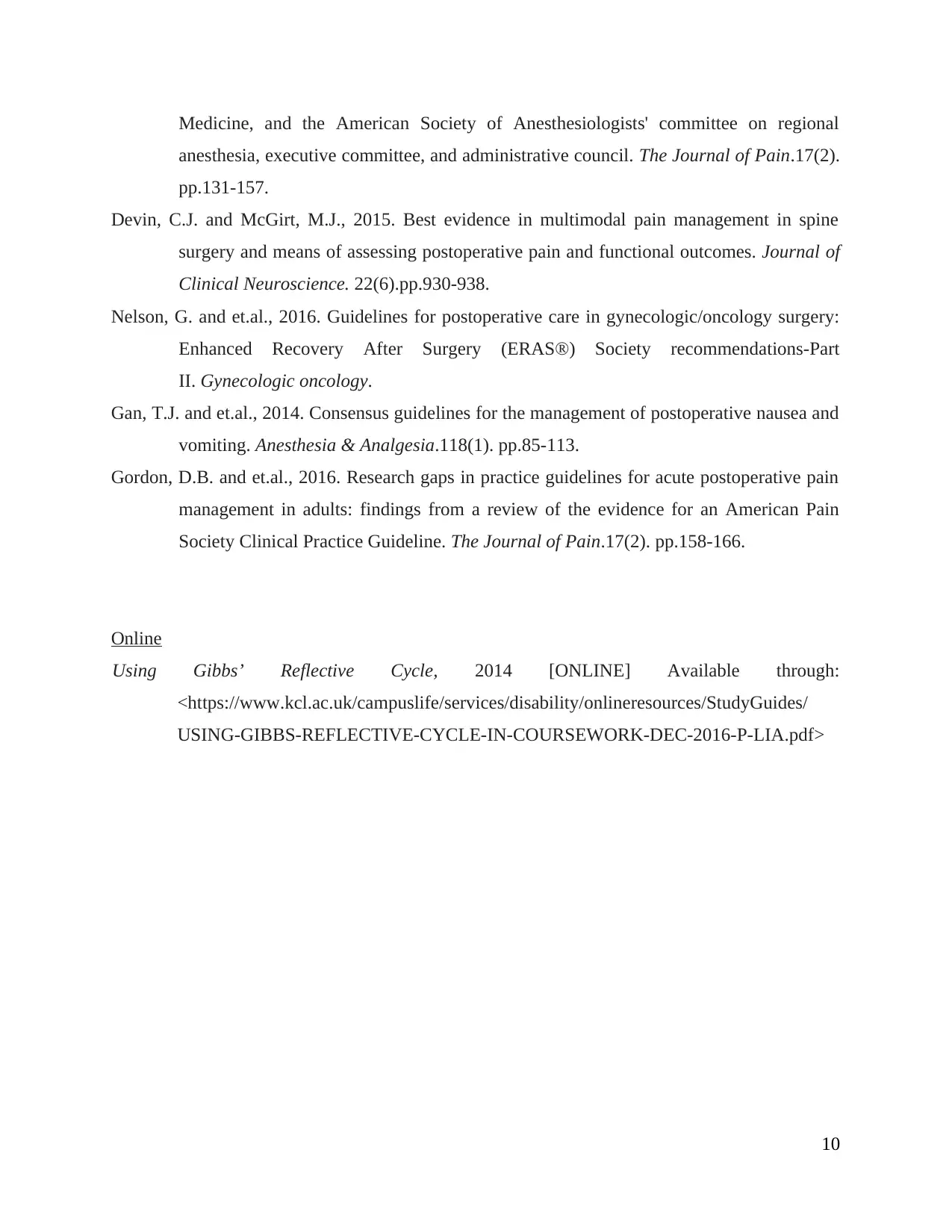
Medicine, and the American Society of Anesthesiologists' committee on regional
anesthesia, executive committee, and administrative council. The Journal of Pain.17(2).
pp.131-157.
Devin, C.J. and McGirt, M.J., 2015. Best evidence in multimodal pain management in spine
surgery and means of assessing postoperative pain and functional outcomes. Journal of
Clinical Neuroscience. 22(6).pp.930-938.
Nelson, G. and et.al., 2016. Guidelines for postoperative care in gynecologic/oncology surgery:
Enhanced Recovery After Surgery (ERAS®) Society recommendations-Part
II. Gynecologic oncology.
Gan, T.J. and et.al., 2014. Consensus guidelines for the management of postoperative nausea and
vomiting. Anesthesia & Analgesia.118(1). pp.85-113.
Gordon, D.B. and et.al., 2016. Research gaps in practice guidelines for acute postoperative pain
management in adults: findings from a review of the evidence for an American Pain
Society Clinical Practice Guideline. The Journal of Pain.17(2). pp.158-166.
Online
Using Gibbs’ Reflective Cycle, 2014 [ONLINE] Available through:
<https://www.kcl.ac.uk/campuslife/services/disability/onlineresources/StudyGuides/
USING-GIBBS-REFLECTIVE-CYCLE-IN-COURSEWORK-DEC-2016-P-LIA.pdf>
10
anesthesia, executive committee, and administrative council. The Journal of Pain.17(2).
pp.131-157.
Devin, C.J. and McGirt, M.J., 2015. Best evidence in multimodal pain management in spine
surgery and means of assessing postoperative pain and functional outcomes. Journal of
Clinical Neuroscience. 22(6).pp.930-938.
Nelson, G. and et.al., 2016. Guidelines for postoperative care in gynecologic/oncology surgery:
Enhanced Recovery After Surgery (ERAS®) Society recommendations-Part
II. Gynecologic oncology.
Gan, T.J. and et.al., 2014. Consensus guidelines for the management of postoperative nausea and
vomiting. Anesthesia & Analgesia.118(1). pp.85-113.
Gordon, D.B. and et.al., 2016. Research gaps in practice guidelines for acute postoperative pain
management in adults: findings from a review of the evidence for an American Pain
Society Clinical Practice Guideline. The Journal of Pain.17(2). pp.158-166.
Online
Using Gibbs’ Reflective Cycle, 2014 [ONLINE] Available through:
<https://www.kcl.ac.uk/campuslife/services/disability/onlineresources/StudyGuides/
USING-GIBBS-REFLECTIVE-CYCLE-IN-COURSEWORK-DEC-2016-P-LIA.pdf>
10
1 out of 12
Your All-in-One AI-Powered Toolkit for Academic Success.
+13062052269
info@desklib.com
Available 24*7 on WhatsApp / Email
![[object Object]](/_next/static/media/star-bottom.7253800d.svg)
Unlock your academic potential
© 2024 | Zucol Services PVT LTD | All rights reserved.





